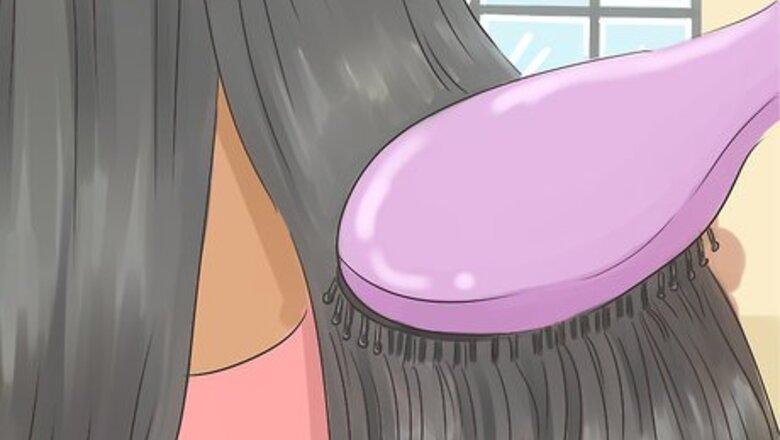
views
- Before cutting your own hair, pull your hair in a low ponytail, tying the hair tie just above where you want to cut your hair. Use sharp hairdressing scissors to cut your hair.
- To make sure your hair is cut perfectly straight, divide your hair into 2 or 4 even ponytails, and lay them in front of your shoulders. Cut them at a slight angle.
- When cutting someone else’s hair, start with the bottom layer. Cut their hair layer by layer to be as exact and precise as possible.
Cutting Your Own Hair

Comb your hair out and straighten it. Before cutting your hair, make sure it’s free of any knots and tangles and that it falls straight. If you have straight hair, you can cut it dry or damp. If you have wavy or curly hair, wash it, dry it, and straighten it so that your cuts will be more precise and even. If you have curly or wavy hair and don’t plan to style it straight, remember to cut it a little longer than you want it to be: once it’s wavy or curly again, it’ll be shorter.
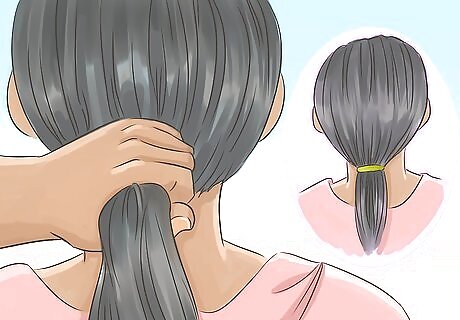
Pull your hair back into a low ponytail. Part your hair down the middle. Pull it back into a low ponytail at the nape of your neck, then secure it with a hair tie. Make sure that the ponytail is neat and smooth, and that all your hairs are in elastic.
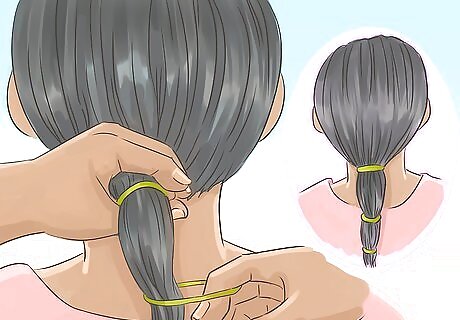
Tie another elastic a few inches/centimeters below the first one. Smooth your ponytail down as much as you can, then wrap another elastic around it. Adding elastics gives you control before and as you cut. Depending on how long your hair is, and how short you plan on cutting it, you may need to add a third elastic below the second one. If you don’t have extra elastics, just gently pull the first elastic down to right above the place you want to cut your hair.
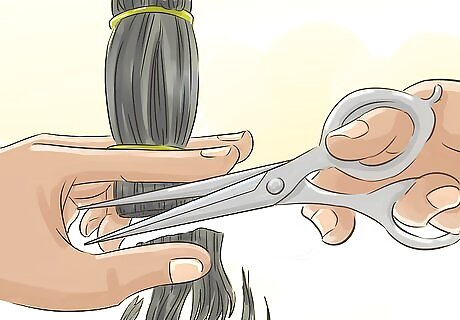
Hold the ponytail in your fingers where you want to cut it, and cut. Make a V-shape with your fore and middle fingers, then close your fingers around the ponytail. Using sharp hairdressing shears, cut your hair slowly and carefully, a little bit at a time. Make sure to cut an inch or so below the hair tie, rather than above, so that it’s easier to flatten out the hair between your fingers. Cutting above the hair tie, where your hair is thickest, will result in a choppier cut.
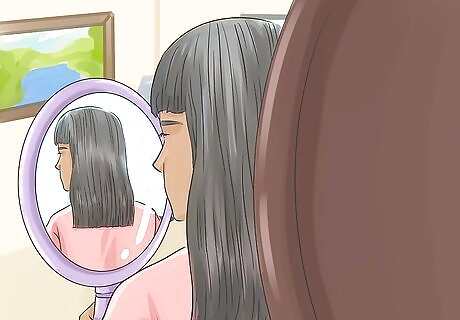
Undo the ponytail and check the shape. Turn around so that your back is facing the mirror, and hold another mirror up in front of you. Your hair will either have a rounded bottom edge or a slight curve. If this is not straight enough for you, proceed to the next step.

Part your hair down the center and make 2 ponytails. Drape the left side of your hair over your left shoulder, and the right side over your right shoulder. Tie them tightly, letting the hair hang over your shoulders. If your hair is particularly thick or unruly, it into 4 ponytails to make it more manageable. Just make sure all ponytails are the same length and lie in front of your shoulders.
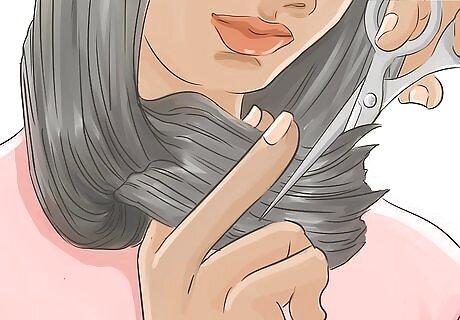
Pinch one ponytail in your fingers and cut. Grab a ponytail, then pinch it between your fore- and middle fingers as you did earlier, and drag your fingers downward at a slight upward angle (that is, with the angle higher nearer your shoulders and lower at your neck). Cut the hair below your fingers using the same process as before. Cutting your hair at this angle will allow you to cut the hair from the back of your head shorter; when you brush your hair out, it will be the same length.

Repeat the process with each ponytail. To ensure that you’re cutting each ponytail at the same length, measure the uncut hair against the cut hair. Take the innermost strands from both the left and right sections. Note where the cut strand ends on the uncut strand with your fingers.
Cutting Someone Else's Hair

Dampen the person’s hair with a spray bottle. While some cuts are best done on dry hair, a straight-across haircut is best done on wet hair to ensure it’s as smooth, straight, and manageable as possible. You don't have to wash the person's hair with shampoo and conditioner, but it needs to be wet (but not soaking). Keep in mind that however short you cut their hair, it will be a bit shorter when it’s fully dry.
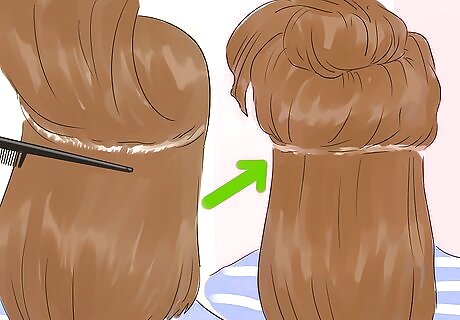
Gather the top three-quarters of their hair into a bun. Use the handle of a rat-tail comb to create a neat part, then pull the hair into a bun at the top of their head. Clip the bun out of the way, or secure it with a hair tie. Leave the bottom portion of their hair loose. Have the person sit in a tall chair so that their hair is at a comfortable cutting level for you.
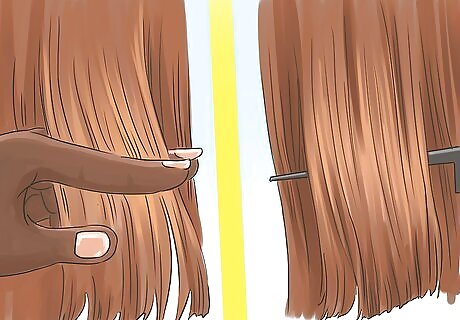
Pinch a strand of loose hair in your fingers. Make a V-shape with your forefinger and middle fingers. Close your fingers against a 1 to 2 inches (2.5 to 5.1 cm)-wide strand in the middle of the loose hair: the middle strand of hair will be your guide for the rest of the hair. You can also use a rat-tail comb to measure out the sections. This will prevent you from accidentally pulling down too hard on it.
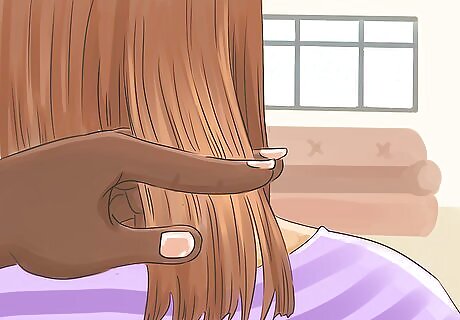
Slide your fingers down the strand to where you want to cut. Keep your hand against the person's back and avoid creating any angle by pulling it away from the back. Make sure your fingers stay parallel to the part you made earlier and the floor. Don’t twist your fingers upwards, flip the hair, or pull the strand away from the person's back. Doing so will cause a slight gradation.
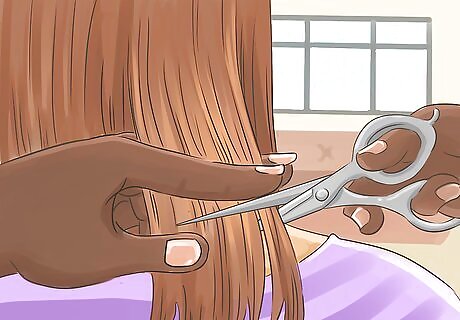
Cut the hair off below your fingers. Use the length of your fingers as a guide. Make sure that you’re using sharp hairdressing shears for this; don’t use ordinary scissors. Ensure the person is sitting straight with their face forward before you cut and that they’re not crossing their legs. Otherwise, you won't be able to cut their hair straight.
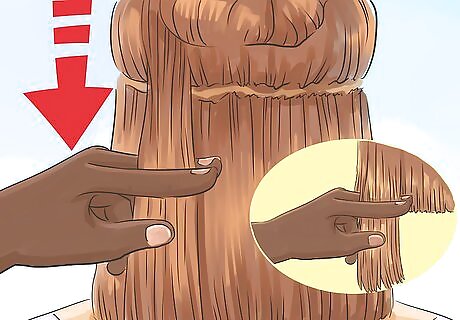
Gather another section of loose hair and measure it against the already-cut one. Take another ⁄2 inch (1.3 cm)-wide section of hair. Add it to a few strands from the section that you already cut. Pinch the section between your fore- and middle fingers, like before. Slide your fingers down until the bottom edge is level with the cut strand.

Cut the hair, then pinch another strand. Measure the new strand up against the previous strand, and cut it. Continue in this manner until you have cut the entire bottom layer of hair. Never pull the strands away from the person's back while cutting them. Keep them as close as possible to their back. Measure up the left and right sides in the front to ensure that they are even.
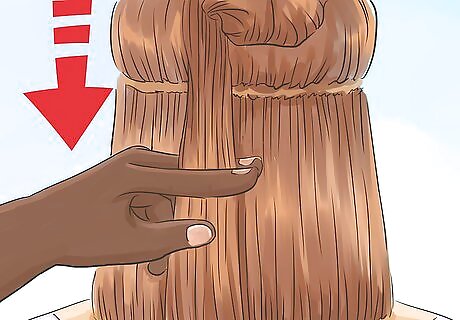
Let down another layer of hair and clip the top layer of hair in a bun. Use the handle of a rat-tail comb to create another neat, horizontal part. Leave enough hair so that you can still see part of the previous layer beneath it. Gather the rest of the hair into a bun once again.
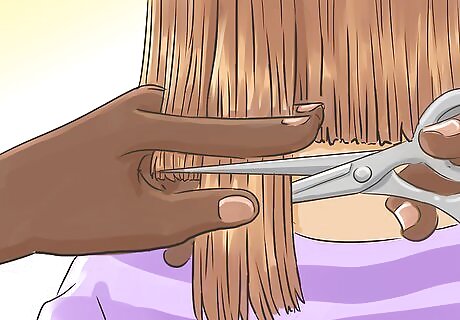
Measure the upper layer against the bottom one and cut it. Take a 1 to 2 inches (2.5 to 5.1 cm) section of hair from the new layer. Add a thin strand from the bottom layer to it and, using the cut hair as your guide, cut the new strand below your fingers as before, and repeat the process with the rest of the hair. Measure the new strands against the previous ones and the new layer against the old one.
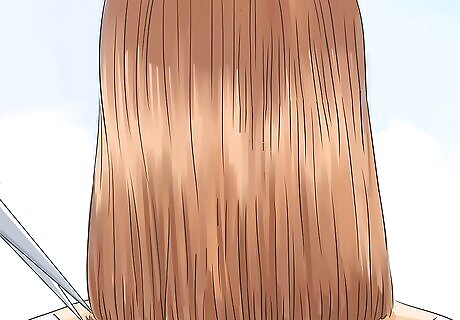
Dry the person's hair, then make any necessary adjustments. If you want to, you can wash the person's hair to get rid of any tiny snippets of hair. Blow dry the person's hair, then trim off any ends that stick out. Since you cut all the hair from behind, the front strands may end up slightly uneven. To even them out, let the hair fall where it would naturally fall by the person’s shoulders and trim it using your fingers as a guide.

















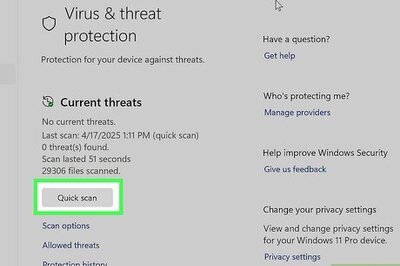


Comments
0 comment